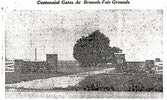2024 Brussels Fall Fair: Fair's history stretches back more than 160 years
After the cancellation of the Brussels Fall Fair in both 2020 and 2021, the Brussels Agricultural Society returned in 2022, though not at its traditional home of the Brussels, Morris and Grey Community Centre. The event marked an enthusiastic return to a traditional fair, held that year at the Four Winds Barn.
Last year, the fair was back at the Brussels, Morris and Grey Community Centre, but in a limited capacity, as its renovation and expansion was still very much underway at the time. This year will mark the full return to the venue the fair has made its home in recent years and translates to an exciting beginning of a future at the new and improved centre, with members of the Brussels Agricultural Society eager to see how the centre works for their event and how it can accommodate the fair for years to come.
A look back at the fair’s history shows that a venue change is not unheard of in the event’s history. Of course, there was 2017 when the fair moved its operations lock, stock and barrel south to Walton to be part of the International Plowing Match. That was a landmark year for the fair and it made history as the first-ever full fall fair to be held in conjunction with an International Plowing Match.
Through the years, there have been significant changes to the fair, from the more recent additions like the fire safety courses hosted by Huron East Fire Department and the change from a traditional midway to inflatable attractions, to older changes like when the Queen of the Fair competition was first incorporated in 1980 and historical changes, like when the fair was originally held in Victoria Park, the site of the Brussels baseball diamond.
Then-Secretary of the Association Mary Douma, in 2012, provided a brief history of the society and the fair to The Citizen for the special Brussels Homecoming edition produced that year. That history is reprinted below:
By Mary Douma
The first Brussels Fall Fairs were held in Victoria Park (where the main ball diamond is today), with the inside department housed in the hall at the Armstrong Hotel (later known as the American Hotel, just south of the Brussels Library on Turnberry Street).
In 1872, three quarters of an acre was purchased for the fairgrounds. It was just north of McDonald Home Hardware, behind the present Optimists’ club house, for $575.
In 1875, the new Agricultural Hall, costing $600, was ready for use.
In 1883, there were also Morris and Grey Township Agricultural Societies that worked with East Huron Agricultural Society (Brussels).
In 1891, 10 more acres were purchased from John Leckie. Horse racing was introduced for the first time. The new competition in 1892 was to determine the “Best Lady Driver”.
In 1895, there was the first Field Crop Competition. The crops were to be turnips and mangels.
In 1900, the directors decided to hold a big concert on the Friday night following the fair in the Town Hall. Attendance at the 1900 Fall Fair was an estimated 5,000.
In 1901, ladies assisted in setting up and displaying exhibits. This became an annual custom and each year two or three women were appointed as assistants.
In 1903, the first contest for children was recorded, that being an apple-naming contest. The first competition in a “Fancy Drill” by school children was held in 1905. There were to be at least 16 children in each drill. The prize went to Ethel school with 25 children taking part.
In 1906, the “Crystal Palace” show hall was built for a cost of $3,263. 1928, the palace was wired for hydro.
In 1929, the Fair Board bought two lots facing Turnberry Street to increase its land base.
Until 1929 there was also a spring fair in April (mostly an exhibition of stallions and bulls) as well as a fall fair held in October.
In 1937, the fair was cancelled due to a polio epidemic.
In 1946, a membership to the East Huron Agricultural Society cost $1 and included two admission tickets. Also in 1946, the field crop section expanded to include wheat, oats and barley. In 1947, the first school parade was held.
In 1949, the large opening in the second storey of the Crystal Palace was closed in and floored with hardwood, making it an ideal floor for dancing. In 1951 there was a variety concert in the arena starting at 8:30 p.m. followed by dancing at the Crystal Palace Ballroom.
In 1952, the women’s division was taken over by the Brussels and Cranbrook Women’s Institutes. In 1954, a water system was installed in the Crystal Palace Ballroom. In 1959, washrooms were installed in the north-east corner of the palace.
In 1961, the fair and society’s 100th anniversary, a centennial stone gateway was erected at the Turnberry Street entrance. In 1966, the name of the Society was
changed to Brussels Agricultural Society.
The first Queen of the Fair Competition was held in 1980. In 1984, the fair moved to the Brussels, Morris and Grey Community Centre. In 1995, the Ambassador competition replaced the Queen of the Fair competition.
In 2006, the youth activities for the two local schools, Grey Central and Brussels Public, were introduced on the Wednesday morning of the fair.


